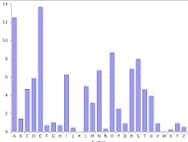Before entering fully into the definition of the term relative frequency, we are going to proceed to discover the etymological origin of the two words that give it shape:
-Frequency, first of all, is a noun that derives from Latin, specifically from “frequentia”, which is the result of the sum of two lexical components of that language: the word “frequens, frequentis”, which can be translated as “full” or “multitude”, and the suffix “-ia”, which is used to indicate “quality”.
-Relative, secondly, is a word that also comes from Latin. In its specific case, it emanates from “relativus”, which can be translated as “has a relationship”, and which is formed from the sum of three lexical components: the prefix “re-”, which indicates “reiteration”; the verb “ferre”, which is synonymous with “carry”, and the suffix “-ivo”, which is used to make clear a “passive or active relationship”.
Frequency is the number of times an event is repeated in a certain period of time. The relative , on the other hand, is that which is not absolute or that is linked to something else.
 The idea of relative frequency is used in the field of statistics . In this context, the number of times an event is reiterated in a sample or in an experiment is known as frequency.
The idea of relative frequency is used in the field of statistics . In this context, the number of times an event is reiterated in a sample or in an experiment is known as frequency.
It is possible to differentiate between absolute frequency and relative frequency . The absolute frequency refers to the number of times the phenomenon appears; The relative frequency, on the other hand, is obtained by dividing the absolute frequency and the sample size .
Suppose that the statistical sample is formed with the prices of a liter bottle of beer from different brands :
$40, $42, $40, $40, $40, $45, $48, $50, $48, $42
The absolute frequency of $40 , for example, is 4 , since in the sample there are 4 brands that offer the beer for $40 (that is, $40 appears 4 times).
The relative frequency of $40 , meanwhile, is 0.4 . The data is obtained by dividing the absolute frequency ( 4 ) and the size of the entire sample ( 10 ). It is common for this data to be expressed as a percentage , for which the result must be multiplied by 100 : 40% .
In the same sample, the absolute frequency of $42 is 2 : there are 2 brands that, in the sample in question, sell a one-liter bottle of beer for $42 . Therefore, $42 appears 2 times in the sample. With that figure , we can calculate the relative frequency of $42 , which is 0.2 (2 / 10) or 20% (0.2 x 100).
In the same way, we cannot ignore that there is what is known as cumulative relative frequency. This is the quotient of dividing the accumulated frequency of a specific value by the total number of data that exists. It must be emphasized that it is measured in percentages and is represented as follows: Ni. However, it can also be represented with Fi.
To all of the above, we have to add that this accumulated relative frequency of each value will always be greater than the known relative frequency. The only exception to this rule will be in the case of the lowest value.
